
|
Now it is very bright as 10.3 mag (July 5, Carlos Labordena). It stays observable at 10 mag in good condition for a long time from spring to summer.
Date(TT) R.A. (2000) Decl. Delta r Elong. m1 Best Time(A, h)
July 10 13 59.32 5 54.6 1.657 2.055 97 10.0 21:00 ( 54, 47)
July 17 14 7.15 2 44.4 1.715 2.056 94 10.1 20:55 ( 55, 43)
|
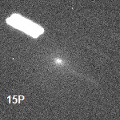
|
It brightened very rapidly. Now it is very bright as 11.1 mag (July 6, Chris Wyatt). It stays 10 mag until August. It stays observable in the morning sky for a long time.
Date(TT) R.A. (2000) Decl. Delta r Elong. m1 Best Time(A, h)
July 10 3 25.73 16 58.6 1.145 0.993 54 10.4 3:09 (263, 21)
July 17 3 56.87 19 39.4 1.179 0.993 53 10.1 3:16 (261, 23)
|

|
Now it is very bright as 11.8 mag (July 6, Chris Wyatt). It stays bright as 10-12 mag until August. In the Southern Hemisphere, it stays observable in excellent condition for a long time. In the Northern Hemisphere, it becomes extremely low after July.
Date(TT) R.A. (2000) Decl. Delta r Elong. m1 Best Time(A, h)
July 10 23 40.60 -37 10.7 0.495 1.346 121 11.3 3:09 (344, 16)
July 17 23 53.43 -40 48.1 0.522 1.381 124 11.5 3:16 (349, 13)
|

|
Now it is 12.6 mag (June 22, Thomas Lehmann). It will brighten up to 10 mag from summer to autumn, and it will be observable in excellent condition.
Date(TT) R.A. (2000) Decl. Delta r Elong. m1 Best Time(A, h)
July 10 2 22.65 15 17.8 1.808 1.733 69 11.8 3:09 (274, 33)
July 17 2 41.74 16 18.4 1.738 1.709 71 11.6 3:16 (275, 36)
|
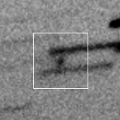
|
Now it is 16.1 mag (June 8, Ken-ichi Kadota). Brightening very rapidly. It will brighten up to 8.5 mag from September to October. But the condition is bad in this apparition. In the Northern Hemisphere, it is observable only in the extremely low sky until July. In the Southern Hemisphere, it will be observable after late August. But it stays locating low for a while. It is fainter than this ephemeris recently.
Date(TT) R.A. (2000) Decl. Delta r Elong. m1 Best Time(A, h)
July 10 5 58.54 35 50.1 2.147 1.260 21 12.1 3:09 (228, 4)
July 17 6 23.83 32 45.3 2.092 1.204 21 11.7 3:16 (231, 3)
|

|
Now it is 12.2 mag (June 17, Thomas Lehmann). It will brighten up to 10 mag in winter in 2022. In the Northern Hemisphere, it stays observable in good condition for a long time, although it became extremely low temporarily from May to June. In the Southern Hemisphere, it is not observable until November.
Date(TT) R.A. (2000) Decl. Delta r Elong. m1 Best Time(A, h)
July 10 5 31.32 48 53.5 4.728 3.924 33 12.2 3:09 (221, 16)
July 17 5 43.96 48 32.5 4.669 3.898 36 12.1 3:16 (223, 18)
|
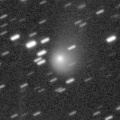
|
Now it is 13.5 mag (July 5, Chris Wyatt). It is expected to be observable at 5-6 mag for a long time from 2022 to 2023. In the Northern Hemisphere, it is not observable at the high light from 2022 summer to 2023 summer. In the Southern Hemisphere, it stays extremely low for a while. But it will be observable in good condition at the high light.
Date(TT) R.A. (2000) Decl. Delta r Elong. m1 Best Time(A, h)
July 10 17 25.12 41 41.6 5.467 5.908 111 12.4 22:10 (180, 83)
July 17 17 19.30 40 50.9 5.435 5.850 109 12.3 21:37 (180, 84)
|
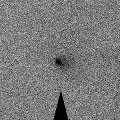
|
It brightened up to 10.1 mag in spring (Apr. 10, Marco Goiato). Now it is fading. It has already faded down to 13.5 mag (July 6, Chris Wyatt). In the Southern Hemisphere, it is locates high in the morning sky. Appearing in the morning sky also in the Northern Hemisphere.
Date(TT) R.A. (2000) Decl. Delta r Elong. m1 Best Time(A, h)
July 10 3 18.20 7 41.6 2.084 1.787 59 13.3 3:09 (273, 17)
July 17 3 32.02 8 11.0 2.066 1.828 62 13.5 3:16 (275, 22)
|

|
Now it is bright as 13.9 mag (July 5, Chris Wyatt). It stays 13 mag until early summer. In the Southern Hemisphere, it stays observable in good condition for a long time. It locates somewhat low in the Northern Hemisphere.
Date(TT) R.A. (2000) Decl. Delta r Elong. m1 Best Time(A, h)
July 10 13 50.61 -11 17.4 3.084 3.443 102 13.7 21:00 ( 43, 33)
July 17 13 46.48 -9 51.7 3.237 3.458 93 13.8 20:55 ( 50, 30)
|

|
Now it is 13.8 mag (July 6, Chris Wyatt). It stays 13-14 mag from 2020 to 2021. It will be observable in good condition after this in the Southern Hemisphere. It locates somewhat low in the Northern Hemisphere.
Date(TT) R.A. (2000) Decl. Delta r Elong. m1 Best Time(A, h)
July 10 19 5.04 -33 40.3 1.955 2.958 168 13.7 23:50 ( 0, 21)
July 17 18 59.51 -34 15.8 1.979 2.967 163 13.8 23:17 ( 0, 21)
|
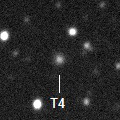
|
Now it is 14.4 mag (July 5, Chris Wyatt). It is expected to brighten up to 11.5 mag in 2022. In the Southern Hemisphere, it stas observable in good condition for a long time, although it becomes extremely low temporarily from August to September. In the Northern Hemisphere, it is not observable until November.
Date(TT) R.A. (2000) Decl. Delta r Elong. m1 Best Time(A, h)
July 10 9 10.10 -22 43.0 5.600 5.051 52 13.9 21:00 ( 79,-25)
July 17 9 17.56 -22 29.6 5.625 5.021 49 13.9 20:55 ( 81,-28)
|
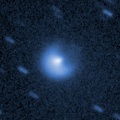
|
Appearing in the morning sky. Now it is 16.4 mag (June 25, Jean-Francois Soulier).
Date(TT) R.A. (2000) Decl. Delta r Elong. m1 Best Time(A, h)
July 10 4 19.40 29 24.0 6.634 5.895 40 13.9 3:09 (245, 17)
July 17 4 24.73 29 39.7 6.562 5.897 45 13.9 3:16 (248, 22)
|
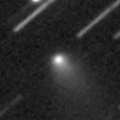
|
Now it is 14.9 mag (June 14, Michael Jager). It will brighten up to 14 mag in summer, and it will be observable in excellent condition. It locates somewhat low in the Southern Hemisphere.
Date(TT) R.A. (2000) Decl. Delta r Elong. m1 Best Time(A, h)
July 10 20 0.03 29 49.5 1.701 2.450 126 14.4 0:51 ( 0, 85)
July 17 19 27.65 31 37.4 1.673 2.424 126 14.3 23:42 ( 0, 87)
|

|
Now it is 15.1 mag (July 6, Chris Wyatt). It will brighten up to 9 mag, and will be observable in good condition in winter.
Date(TT) R.A. (2000) Decl. Delta r Elong. m1 Best Time(A, h)
July 10 0 48.06 0 27.8 1.395 1.816 96 14.8 3:09 (307, 41)
July 17 1 2.79 1 55.8 1.286 1.761 99 14.5 3:16 (311, 46)
|
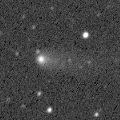
|
Now it is 14.8 mag (July 6, Chris Wyatt). It was expected to brighten up to 13 mag from spring to summer. But actually, it is fainter than originally expected. It stays 14-15 mag until early autumn. In the Southern Hemisphere, it stays observable in good condition for a long time. In the Northern Hemisphere, it is not observable until July in 2022.
Date(TT) R.A. (2000) Decl. Delta r Elong. m1 Best Time(A, h)
July 10 0 6.96 -85 55.9 3.072 3.599 113 14.6 3:09 (358,-31)
July 17 0 17.72 -86 34.5 3.089 3.602 112 14.6 3:16 (359,-32)
|
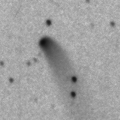
|
Now it is 14.9 mag (July 6, Chris Wyatt). It stays 14-15 mag until the end of 2021. In the Southern Hemisphere, it stays observable in good condition for a long time. It locates low in the Northern Hemisphere.
Date(TT) R.A. (2000) Decl. Delta r Elong. m1 Best Time(A, h)
July 10 23 41.17 -34 16.5 3.799 4.417 121 14.6 3:09 (342, 18)
July 17 23 38.50 -34 12.4 3.737 4.429 127 14.6 3:16 (350, 20)
|

|
Now it is 15.0 mag (July 6, Chris Wyatt). It stays at 14-15 mag for a long time from 2021 to 2022. It stays observable in good condition after this while brightening gradually.
Date(TT) R.A. (2000) Decl. Delta r Elong. m1 Best Time(A, h)
July 10 16 55.12 -6 37.6 4.228 5.072 142 14.7 21:41 ( 0, 48)
July 17 16 48.31 -7 39.2 4.290 5.063 135 14.7 21:06 ( 0, 47)
|

|
It will brighten up to 14.5 mag from spring to summer. In the Southern Hemisphere, it stays observable in excellent condition for a long time. In the Northern Hemisphere, it is not observable after this.
Date(TT) R.A. (2000) Decl. Delta r Elong. m1 Best Time(A, h)
July 10 7 43.65 -65 56.1 2.609 2.773 88 15.0 21:00 ( 28,-47)
July 17 8 19.81 -64 12.0 2.681 2.795 85 15.1 20:55 ( 31,-46)
|
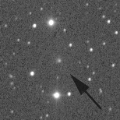
|
It brightened up to 14.2 mag in early summer (June 10, Thomas Lehmann). Now it is not observable. It will be fading after this. In the Northern Hemisphere, it will appear in the morning sky at 16 mag in October. In the Southern Hemisphere, it will never be observable again.
Date(TT) R.A. (2000) Decl. Delta r Elong. m1 Best Time(A, h)
July 10 9 15.86 11 3.9 2.775 1.969 30 15.2 21:00 (107, -5)
July 17 9 29.40 12 36.4 2.826 1.968 26 15.2 20:55 (110, -6)
|
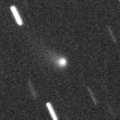
|
Now it is 15.8 mag (June 30, Thomas Lehmann). In the Northern Hemisphere, it stays observable at 15-16 mag for a long time from spring to early 2022. In the Southern Hemisphere, it is not observable until the end of 2021.
Date(TT) R.A. (2000) Decl. Delta r Elong. m1 Best Time(A, h)
July 10 12 24.48 60 41.4 3.330 3.032 64 15.3 21:00 (143, 46)
July 17 12 22.63 57 21.7 3.379 3.023 61 15.4 20:55 (138, 43)
|

|
It brightened up to 11.6 mag in winter (Feb. 18, Thomas Lehmann). Now it is fading. It has already faded down to 15.2 mag (June 22, Thomas Lehmann). In the Southern Hemisphere, it stays observable in good condition after this. In the Northern Hemisphere, it will never be observable after this.
Date(TT) R.A. (2000) Decl. Delta r Elong. m1 Best Time(A, h)
July 10 5 23.83 -53 45.5 3.206 3.188 79 15.3 3:09 (315,-36)
July 17 5 27.49 -54 33.4 3.247 3.253 81 15.4 3:16 (317,-32)
|

|
Now it is 15.9 mag (June 29, Thomas Lehmann). It will brighten up to 13 mag in 2022. In 2021, it is observable at 14-15 mag in good condition.
Date(TT) R.A. (2000) Decl. Delta r Elong. m1 Best Time(A, h)
July 10 13 6.82 -2 53.3 3.360 3.490 88 15.4 21:00 ( 59, 32)
July 17 13 10.68 -3 34.3 3.444 3.476 83 15.4 20:55 ( 62, 28)
|
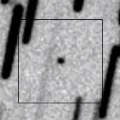
|
Now it is 17.3 mag (June 29, Francois Kugel). It will brighten very rapidly, and it will be observable at 10 mag in good condition from October to December. In the Northern Hemisphere, it locates somewhat low at the high light.
Date(TT) R.A. (2000) Decl. Delta r Elong. m1 Best Time(A, h)
July 10 16 9.88 12 14.5 0.765 1.568 122 16.0 21:00 ( 3, 67)
July 17 16 9.83 9 36.4 0.756 1.531 118 15.5 20:55 ( 15, 64)
|

|
Now it is 16.7 mag (June 11, J. L. Virlichie, P. Traverse, J. P. Desgrees). It will brighten up to 15 mag from summer to autumn. In the Southern Hemisphere, it stays observable for a long time. In the Northern Hemisphere, it will be getting higher gradually after this, and it will be observable in good condition after summer.
Date(TT) R.A. (2000) Decl. Delta r Elong. m1 Best Time(A, h)
July 10 3 24.61 9 52.9 1.896 1.586 56 15.7 3:09 (270, 17)
July 17 3 43.81 12 0.4 1.844 1.568 58 15.5 3:16 (270, 21)
|

|
Now it is 15.6 mag (June 26, ATLAS-MLO, Mauna Loa). It stays observable at 15-16 mag in good condition until autumn.
Date(TT) R.A. (2000) Decl. Delta r Elong. m1 Best Time(A, h)
July 10 16 39.33 -17 39.4 4.028 4.878 142 15.6 21:25 ( 0, 37)
July 17 16 35.98 -16 35.5 4.099 4.874 135 15.6 20:55 ( 0, 38)
|

|
Now it is 15.7 mag (June 9, Toshihiko Ikemura, Hirohisa Sato). It is expected to brighten up to 13 mag in 2022. In the Southern Hemisphere, it stays observable in good condition for a long time. In the Northern Hemisphere, it will be unobservable soon.
Date(TT) R.A. (2000) Decl. Delta r Elong. m1 Best Time(A, h)
July 10 12 1.00 -20 49.7 4.516 4.483 81 15.8 21:00 ( 57, 8)
July 17 12 0.25 -21 6.6 4.586 4.439 75 15.8 20:55 ( 61, 4)
|
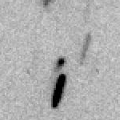
|
Now it is 17.0 mag (June 25, ATLAS-HKO, Haleakala). It is expected to brighten up to 15 mag from summer to autumn, and it will be observable in good condition. However, it is fainter than this ephemeris recently.
Date(TT) R.A. (2000) Decl. Delta r Elong. m1 Best Time(A, h)
July 10 23 14.61 -5 15.4 1.657 2.339 120 16.0 3:09 (340, 48)
July 17 23 18.56 -5 35.7 1.582 2.330 126 15.8 3:16 (351, 49)
|

|
Now it is 17.0 mag (June 16, Michael Jager). It will approach to Earth down to 0.2 a.u. in December, and it is expected to brighten up to 4 mag. In the Northern Hemisphere, it stays observable in good condition for a long time until December while the comet is brightening gradually. In the Southern Hemisphere, it is not observable until mid December. Actually, it is somewhat fainter than this ephemeris recently.
Date(TT) R.A. (2000) Decl. Delta r Elong. m1 Best Time(A, h)
July 10 10 28.58 49 56.4 3.586 2.979 46 16.0 21:00 (133, 28)
July 17 10 30.05 48 41.3 3.554 2.890 42 15.9 20:55 (133, 25)
|
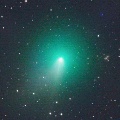
|
It brightened up to 8.9 mag in April (Apr. 12, Carlos Labordena). Now it is fading. It has already faded down to 14.8 mag (June 30, Thomas Lehmann). It will be fading and getting lower rapidly after this. It will be unobservable at 17 mag in July.
Date(TT) R.A. (2000) Decl. Delta r Elong. m1 Best Time(A, h)
July 10 10 56.17 15 20.2 2.710 2.235 52 15.9 21:00 ( 97, 17)
July 17 10 58.18 14 30.6 2.901 2.318 46 16.3 20:55 ( 99, 13)
|
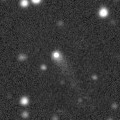
|
Now it is 16.2 mag (June 25, ATLAS-HKO, Haleakala). It stays observable at 16 mag from 2021 to 2022.
Date(TT) R.A. (2000) Decl. Delta r Elong. m1 Best Time(A, h)
July 10 13 38.26 -0 13.1 4.549 4.749 95 15.9 21:00 ( 54, 39)
July 17 13 39.57 0 25.1 4.657 4.741 88 16.0 20:55 ( 60, 36)
|
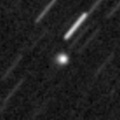
|
Now it is 16.7 mag (July 1, Thomas Lehmann). It is expected to brighten up to 11 mag in 2023. In the Northern Hemisphere, it stays observable in good condition for a long time. It locates extremely low in the Southern Hemisphere.
Date(TT) R.A. (2000) Decl. Delta r Elong. m1 Best Time(A, h)
July 10 16 51.06 49 49.1 6.161 6.434 101 16.1 21:36 (180, 75)
July 17 16 42.73 49 8.0 6.154 6.389 98 16.0 21:00 (180, 76)
|

|
Now it is 15.7 mag (June 9, Toshihiko Ikemura, Hirohisa Sato). In the Northern Hemisphere, it stays observable for a long time while it is getting fainter slowly. In the Southern Hemisphere, it will never be observable again.
Date(TT) R.A. (2000) Decl. Delta r Elong. m1 Best Time(A, h)
July 10 13 30.06 57 54.3 6.481 6.260 73 16.0 21:00 (143, 55)
July 17 13 29.97 56 31.6 6.577 6.308 70 16.1 20:55 (139, 52)
|
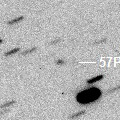
|
Now it is 17.3 mag (June 13, Francois Kugel). It will brighten up to 15.5 mag from summer to autumn. It stays observable for a long time.
Date(TT) R.A. (2000) Decl. Delta r Elong. m1 Best Time(A, h)
July 10 15 7.94 -13 15.7 1.218 1.943 120 16.2 21:00 ( 21, 39)
July 17 15 11.70 -13 36.3 1.252 1.915 114 16.1 20:55 ( 26, 37)
|

|
It brightened up to 3 mag in December in the SOHO spacecraft images (Dec. 18, Hirohisa Sato). Now it is 15.6 mag (June 15, Michael Jager). It stays observable in good condition after this while the comet will be fading.
Date(TT) R.A. (2000) Decl. Delta r Elong. m1 Best Time(A, h)
July 10 0 20.86 19 44.2 3.283 3.515 94 16.3 3:09 (292, 59)
July 17 0 19.23 19 59.6 3.260 3.600 101 16.4 3:16 (303, 66)
|

|
Now it is 16.0 mag (June 27, ATLAS-HKO, Haleakala). Fading slowly. In the Northern Hemisphere, it stays observable in good condition for a long time. It is not observable after this in the Southern Hemisphere.
Date(TT) R.A. (2000) Decl. Delta r Elong. m1 Best Time(A, h)
July 10 17 14.82 57 48.8 5.242 5.443 95 16.3 21:59 (180, 67)
July 17 17 2.97 57 32.4 5.303 5.474 94 16.3 21:20 (180, 68)
|

|
Now it is 16.6 mag (June 29, ATLAS-MLO, Mauna Loa). It is observable at 16 mag from 2020 to 2021. It locates low in the Southern Hemisphere.
Date(TT) R.A. (2000) Decl. Delta r Elong. m1 Best Time(A, h)
July 10 23 3.97 45 18.3 5.842 6.016 94 16.3 3:09 (215, 77)
July 17 22 58.74 45 14.2 5.759 6.023 100 16.3 3:16 (184, 80)
|

|
Now it is 16.2 mag (June 29, ATLAS-MLO, Mauna Loa). It stays at 16-17 mag from 2020 to 2021. In the Northern Hemisphere, it stays observable in good condition for a long time. It locates extremely low in the Southern Hemisphere.
Date(TT) R.A. (2000) Decl. Delta r Elong. m1 Best Time(A, h)
July 10 19 4.99 51 17.6 8.508 8.849 106 16.4 23:50 (180, 74)
July 17 18 59.22 51 32.5 8.509 8.852 106 16.4 23:16 (180, 73)
|
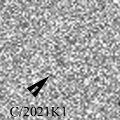
|
Now it is 16.1 mag (June 17, ATLAS-HKO, Haleakala). It stays 16.5 mag until August and stays observable in good condition.
Date(TT) R.A. (2000) Decl. Delta r Elong. m1 Best Time(A, h)
July 10 0 46.78 -3 53.8 2.228 2.580 98 16.4 3:09 (311, 38)
July 17 0 54.00 -4 9.8 2.167 2.598 103 16.4 3:16 (318, 42)
|
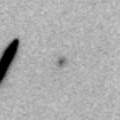
|
Now it is 17.1 mag (June 10, J. L. Virlichie, P. Traverse, J. P. Desgrees). It will brighten rapidly up to 15 mag in autumn. It will be observable in excellent condition in the Northern Hemisphere. It locates somewhat low in the Southern Hemisphere.
Date(TT) R.A. (2000) Decl. Delta r Elong. m1 Best Time(A, h)
July 10 2 49.34 9 18.9 1.938 1.769 65 16.6 3:09 (275, 24)
July 17 3 6.57 10 57.7 1.869 1.747 67 16.4 3:16 (277, 28)
|

|
Now it is 17.1 mag (June 22, Thomas Lehmann). It will brighten up to 12.5 mag in 2022 summer. In the Southern Hemisphere, it stays observable in excellent condition for a long time. In the Northern Hemisphere, it is not observable until August in 2022.
Date(TT) R.A. (2000) Decl. Delta r Elong. m1 Best Time(A, h)
July 10 3 49.08 -48 11.0 5.037 5.040 84 16.5 3:09 (315,-21)
July 17 3 52.75 -49 36.9 4.931 4.991 87 16.4 3:16 (319,-17)
|

|
It had been observed as 8-9 mag for a long time in 2020. Now it is fading. It has already faded down to 16.2 mag (June 20, ATLAS-HKO, Haleakala). It will be observable in good condition after this in the Southern Hemisphere. It locates extremely low after this in the Northern Hemisphere.
Date(TT) R.A. (2000) Decl. Delta r Elong. m1 Best Time(A, h)
July 10 16 19.48 -46 28.9 4.352 5.142 136 16.6 21:06 ( 0, 8)
July 17 16 15.06 -46 19.7 4.482 5.204 130 16.7 20:55 ( 4, 8)
|
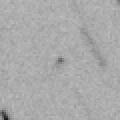
|
Now it is 18.6 mag (June 25, L. Buzzi, L. Demetz, N. Paul, A. Aletti). It will brighten rapidly up to 9 mag in winter. It will be observable in good condition.
Date(TT) R.A. (2000) Decl. Delta r Elong. m1 Best Time(A, h)
July 10 23 59.72 -41 46.2 1.878 2.528 118 16.9 3:09 (341, 10)
July 17 0 6.00 -43 23.0 1.781 2.477 122 16.6 3:16 (347, 10)
|
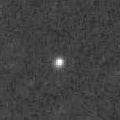
|
Now it is 16.6 mag (June 29, ATLAS-MLO, Mauna Loa). It is expected to brighten up to 10 mag in 2023. In the Northern Hemisphere, it stays observable in good condition until 2023 autumn. In the Southern Hemipshere, it stays extremely low until mid July, then it becomes unobservable for a while. But it becomes observable in good condition after 2023 summer.
Date(TT) R.A. (2000) Decl. Delta r Elong. m1 Best Time(A, h)
July 10 12 0.69 37 7.5 7.283 6.865 62 16.7 21:00 (112, 40)
July 17 12 1.19 36 45.0 7.311 6.812 57 16.7 20:55 (113, 35)
|
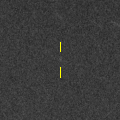
|
Now it is 18.1 mag (June 18, W. Hasubick). It will brighten up to 15-16 mag in autumn and it will be observable in good condition.
Date(TT) R.A. (2000) Decl. Delta r Elong. m1 Best Time(A, h)
July 10 23 31.25 -5 34.6 1.544 2.194 116 16.9 3:09 (334, 46)
July 17 23 34.62 -4 35.0 1.472 2.187 121 16.7 3:16 (345, 49)
|

|
Now it is 17.0 mag (June 24, Slooh.com Canary Islands Observatory). In the Northern Hemisphere, it stays observable in good condition while the comet will be fading. In the Southern Hemipsphere, it stays locating extremely low after this.
Date(TT) R.A. (2000) Decl. Delta r Elong. m1 Best Time(A, h)
July 10 3 38.99 34 45.0 2.879 2.338 48 16.7 3:09 (245, 27)
July 17 3 53.14 35 55.3 2.843 2.361 52 16.8 3:16 (245, 31)
|

|
Now it is 16.4 mag (June 28, ATLAS-HKO, Haleakala). It will be fading after this, and it will be fainter than 18 mag in October.
Date(TT) R.A. (2000) Decl. Delta r Elong. m1 Best Time(A, h)
July 10 15 36.59 -19 54.3 4.330 5.031 128 16.8 21:00 ( 11, 34)
July 17 15 30.00 -20 16.2 4.456 5.053 120 16.9 20:55 ( 19, 32)
|

|
Now it is 16.7 mag (June 25, ATLAS-MLO, Mauna Loa). It is expected to brighten up to 11 mag in 2023. In the Northern Hemisphere, it is observable in good condition in 2021. But it is observable only until November in 2022. In the Southern Hemisphere, it locates extremely low in 2021. But it will be observable in good condition at the high light.
Date(TT) R.A. (2000) Decl. Delta r Elong. m1 Best Time(A, h)
July 10 17 55.13 44 59.2 6.264 6.683 110 16.9 22:40 (180, 80)
July 17 17 49.57 44 15.1 6.228 6.635 109 16.8 22:07 (180, 81)
|

|
Now it is 18.1 mag (June 29, Thomas Lehmann). It will be observable at 11 mag from winter to spring in 2022. In 2021, it is observable until July or August when it brightens up to 16-17 mag.
Date(TT) R.A. (2000) Decl. Delta r Elong. m1 Best Time(A, h)
July 10 11 3.79 9 51.3 3.172 2.731 55 17.0 21:00 ( 91, 16)
July 17 11 12.05 8 57.1 3.206 2.689 51 16.9 20:55 ( 92, 12)
|
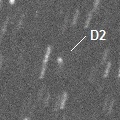
|
Now it is 17.4 mag (June 21, ATLAS-MLO, Mauna Loa). It will brighten up to 15.5 mag in winter. In the Northern Hemisphere, it stays observable in good condition for a long time. It is not observable at all in the Southern Hemisphere.
Date(TT) R.A. (2000) Decl. Delta r Elong. m1 Best Time(A, h)
July 10 19 55.44 71 21.0 3.516 3.594 86 17.0 0:45 (180, 54)
July 17 19 26.83 72 52.8 3.482 3.556 85 16.9 23:41 (180, 52)
|

|
Now it is 16.0 mag (June 25, Slooh.com Canary Islands Observatory). In the Northern Hemisphere, it stays observable in good condition after this while the comet will be fading. In the Southern Hemisphere, it stays locating extremely low for a long time.
Date(TT) R.A. (2000) Decl. Delta r Elong. m1 Best Time(A, h)
July 10 3 39.35 28 46.2 2.627 2.106 49 17.0 3:09 (251, 24)
July 17 3 52.94 30 1.3 2.619 2.156 52 17.0 3:16 (252, 28)
|
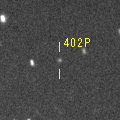
|
First return of a new periodic comet observed at 16 mag from 2003 to 2004. Now it is 16.8 mag (Apr. 11, J. Drummond). It will brighten up to 16 mag in winter, and it will be observable in excellent condition. It will be getting higher gradually.
Date(TT) R.A. (2000) Decl. Delta r Elong. m1 Best Time(A, h)
July 10 5 16.53 1 57.8 4.823 4.039 35 17.0 3:09 (260,-10)
July 17 5 24.49 2 9.5 4.767 4.031 39 17.0 3:16 (264, -5)
|
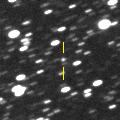
|
Now it is 17.1 mag (June 27, ATLAS-HKO, Haleakala). It is expected to brighten up to 11 mag from spring to summer in 2022. In the Southen Hemisphere, it locates somewhat low in 2021, but it will be observable in good condition at the high light for a long time. In the Northern Hemisphere, it is observable in good condition in 2021, but it will not be observable at the high light.
Date(TT) R.A. (2000) Decl. Delta r Elong. m1 Best Time(A, h)
July 10 20 12.69 37 52.8 3.678 4.257 118 17.1 1:02 (180, 87)
July 17 20 2.42 37 19.4 3.575 4.194 121 17.0 0:24 (180, 88)
|

|
First return of a new periodic comet observed at 17 mag in 2014. It has not been observed yet in this apparition. It is expected to brighten up to 17 mag from summer to autumn, and it will be observable in good condition.
Date(TT) R.A. (2000) Decl. Delta r Elong. m1 Best Time(A, h)
July 10 1 19.51 16 15.7 1.470 1.686 83 17.1 3:09 (283, 46)
July 17 1 33.25 18 19.5 1.429 1.696 86 17.1 3:16 (285, 51)
|

|
Now it is 19.7 mag (June 12, Francois Kugel). It will brighten very rapidly up to 14 mag, and it will be observable in excellent condition in autumn.
Date(TT) R.A. (2000) Decl. Delta r Elong. m1 Best Time(A, h)
July 10 23 41.92 1 29.0 1.484 2.080 111 17.6 3:09 (326, 52)
July 17 23 49.98 2 10.2 1.386 2.044 115 17.2 3:16 (335, 55)
|

|
Now it is 16.8 mag (June 10, Toshihiko Ikemura, Hirohisa Sato). It will be fading slowly.
Date(TT) R.A. (2000) Decl. Delta r Elong. m1 Best Time(A, h)
July 10 17 19.13 -12 7.9 6.906 7.805 150 17.3 22:05 ( 0, 43)
July 17 17 14.36 -11 52.9 6.997 7.830 142 17.3 21:32 ( 0, 43)
|

|
Appearing in the morning sky. In the Northern Hemisphere, it stays observable at 17 mag in good condition until winter. In the Southern Hemisphere, it stays locating extremely low for a while.
Date(TT) R.A. (2000) Decl. Delta r Elong. m1 Best Time(A, h)
July 10 4 24.53 36 51.6 2.592 1.924 39 17.3 3:09 (238, 20)
July 17 4 46.16 37 27.0 2.554 1.919 41 17.3 3:16 (239, 22)
|
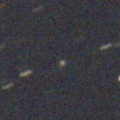
|
Now it is 17.4 mag (June 26, Michael Jager). It stays observable at 17-18 mag for a long time until 2024.
Date(TT) R.A. (2000) Decl. Delta r Elong. m1 Best Time(A, h)
July 10 14 26.16 -5 48.8 8.705 9.076 108 17.4 21:00 ( 37, 42)
July 17 14 24.02 -5 39.2 8.815 9.066 101 17.4 20:55 ( 44, 39)
|
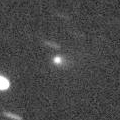
|
First return of a new periodic comet which brightened up to 16 mag in 2014. Now it is 16.9 mag (June 5, Thomas Lehmann). It stays observable at 16-17 mag in good condition until July.
Date(TT) R.A. (2000) Decl. Delta r Elong. m1 Best Time(A, h)
July 10 12 46.45 -5 42.2 1.971 2.141 85 17.4 21:00 ( 61, 26)
July 17 12 55.54 -7 27.0 2.043 2.140 81 17.5 20:55 ( 62, 23)
|
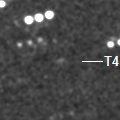
|
Now it is extremely faint as 20.5 mag (June 17, M. Jaeger, E. Prosperi, S. Prosperi). It was predicted to brighten up to 17.5 mag in 2021 summer. But actually, it is much fainter than predicted. It is not observable in the Southern Hemisphere.
Date(TT) R.A. (2000) Decl. Delta r Elong. m1 Best Time(A, h)
July 10 8 24.60 79 4.2 2.567 2.193 57 17.5 21:00 (168, 30)
July 17 10 1.65 77 42.1 2.544 2.196 58 17.4 20:55 (165, 33)
|
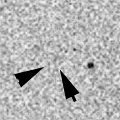
|
Now it is 20 mag (May 28, Giuseppe Pappa). It will brighten up to 14.5 mag in 2022 winter. In 2021, it stays observable in good condition while the comet will be brightening gradually.
Date(TT) R.A. (2000) Decl. Delta r Elong. m1 Best Time(A, h)
July 10 23 8.21 -12 35.1 2.724 3.401 124 17.7 3:09 (344, 41)
July 17 23 8.36 -12 55.8 2.621 3.375 130 17.5 3:16 (355, 42)
|

|
First return of a new periodic comet which brightened up to 17 mag in 2012. Now it is 18.3 mag (June 30, ATLAS-MLO, Mauna Loa). In the Southern Hemisphere, it is observable at 17.5 mag in excellent condition in summer. It locates low in the Northern Hemisphere.
Date(TT) R.A. (2000) Decl. Delta r Elong. m1 Best Time(A, h)
July 10 20 4.49 -36 42.1 0.906 1.900 162 17.8 0:54 ( 0, 18)
July 17 19 59.50 -37 59.0 0.853 1.848 162 17.6 0:22 ( 0, 17)
|

|
Now it is 17.5 mag (June 14, Toshihiko Ikemura, Hirohisa Sato). It will brighten up to 16 mag in 2022. In 2021, it stays observable at 18 mag until September.
Date(TT) R.A. (2000) Decl. Delta r Elong. m1 Best Time(A, h)
July 10 13 27.63 -0 3.1 3.046 3.254 92 17.7 21:00 ( 57, 38)
July 17 13 31.71 -0 53.4 3.129 3.243 87 17.8 20:55 ( 60, 34)
|

|
First return of a new periodic comet which brightened up to 17 mag in 2006. Now it is 17.4 mag (June 15, Taras Prystavski). It stays 18 mag from 2021 to 2022.
Date(TT) R.A. (2000) Decl. Delta r Elong. m1 Best Time(A, h)
July 10 22 51.15 -66 41.8 2.682 3.362 124 17.9 3:09 (357,-12)
July 17 22 49.20 -67 38.0 2.650 3.345 125 17.9 3:11 ( 0,-12)
|

|
It brightened up to 13.8 mag in autumn in 2019 (Sept. 3, 2019, Chris Wyatt). Now it is fading slowly. It stays 18 mag until autumn.
Date(TT) R.A. (2000) Decl. Delta r Elong. m1 Best Time(A, h)
July 10 0 50.30 19 49.2 8.041 8.076 88 17.9 3:09 (285, 54)
July 17 0 50.04 20 15.8 7.972 8.120 94 17.9 3:16 (292, 61)
|

|
It brightened up to 18.5 mag in 2020 spring (Apr. 2, 2020, W. Hasubick). It has passed the perihelion in 2020 October. At the discovery in 2005, it stayed bright for several years even after the perihelion passage. In this apparition, it may stay observable at 18 mag from 2021 to 2024.
Date(TT) R.A. (2000) Decl. Delta r Elong. m1 Best Time(A, h)
July 10 23 49.58 -22 44.4 3.181 3.761 117 18.0 3:09 (337, 29)
July 17 23 50.91 -23 22.8 3.122 3.780 123 17.9 3:16 (345, 30)
|
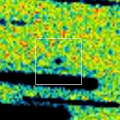
|
It was expected to brighten up to 13 mag from spring to summer. But actually, it is extremely faint as 17.9 mag (Apr. 5, J. L. Virlichie, P. Traverse, J. P. Desgrees). In the Southern Hemisphere, it stays observable in good condition for a long time. In the Northern Hemisphere, it is not observable until late August.
Date(TT) R.A. (2000) Decl. Delta r Elong. m1 Best Time(A, h)
July 10 5 13.09 -30 53.5 1.835 1.608 60 19.5 3:09 (290,-27)
July 17 5 28.57 -29 13.7 1.886 1.639 60 19.6 3:16 (291,-23)
|
|
![]()
 C/2017 U7 ( PanSTARRS )
C/2017 U7 ( PanSTARRS ) 241P/LINEAR
241P/LINEAR C/2020 F2 ( ATLAS )
C/2020 F2 ( ATLAS ) 413P/2020 W4 ( Larson )
413P/2020 W4 ( Larson ) C/2020 T4 ( PanSTARRS )
C/2020 T4 ( PanSTARRS ) 119P/Parker-Hartley
119P/Parker-Hartley P/2021 L5 ( La Sagra )
P/2021 L5 ( La Sagra ) 152P/Helin-Lawrence
152P/Helin-Lawrence P/2021 L1 ( Christensen )
P/2021 L1 ( Christensen ) C/2017 B3 ( LINEAR )
C/2017 B3 ( LINEAR ) 378P/2019 E2 ( McNaught )
378P/2019 E2 ( McNaught ) C/2020 K5 ( PanSTARRS )
C/2020 K5 ( PanSTARRS )![]()




























































